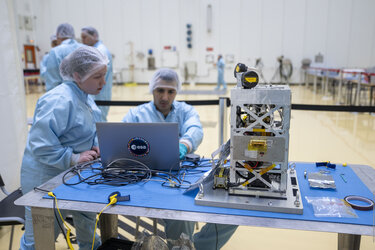Accept all cookies Accept only essential cookies See our Cookie Notice

About ESA
The European Space Agency (ESA) is Europe’s gateway to space. Its mission is to shape the development of Europe’s space capability and ensure that investment in space continues to deliver benefits to the citizens of Europe and the world.
Highlights
ESA - United space in Europe
This is ESA ESA facts Member States & Cooperating States Funding Director General Top management For Member State Delegations European vision European Space Policy ESA & EU Space Councils Responsibility & Sustainability Annual Report Calendar of meetings Corporate newsEstablishments & sites
ESA Headquarters ESA ESTEC ESA ESOC ESA ESRIN ESA EAC ESA ESAC Europe's Spaceport ESA ESEC ESA ECSAT Brussels Office Washington OfficeWorking with ESA
Business with ESA ESA Commercialisation Gateway Law at ESA Careers Cyber resilience at ESA IT at ESA Newsroom Partnerships Merchandising Licence Education Open Space Innovation Platform Integrity and Reporting Administrative Tribunal Health and SafetyMore about ESA
History ESA Historical Archives Exhibitions Publications Art & Culture ESA Merchandise Kids Diversity ESA Brand CentreLatest
Space in Member States
Find out more about space activities in our 23 Member States, and understand how ESA works together with their national agencies, institutions and organisations.
Science & Exploration
Exploring our Solar System and unlocking the secrets of the Universe
Go to topicAstronauts
Missions
Juice Euclid Webb Solar Orbiter BepiColombo Gaia ExoMars Cheops Exoplanet missions More missionsActivities
International Space Station Orion service module Gateway Concordia Caves & Pangaea BenefitsLatest
Space Safety
Protecting life and infrastructure on Earth and in orbit
Go to topicAsteroids
Asteroids and Planetary Defence Asteroid danger explained Flyeye telescope: asteroid detection Hera mission: asteroid deflection Near-Earth Object Coordination CentreSpace junk
About space debris Space debris by the numbers Space Environment Report In space refuelling, refurbishing and removingSafety from space
Clean Space ecodesign Zero Debris Technologies Space for Earth Supporting Sustainable DevelopmentLatest
Applications
Using space to benefit citizens and meet future challenges on Earth
Go to topicObserving the Earth
Observing the Earth Future EO Copernicus Meteorology Space for our climate Satellite missionsCommercialisation
ESA Commercialisation Gateway Open Space Innovation Platform Business Incubation ESA Space SolutionsLatest
Enabling & Support
Making space accessible and developing the technologies for the future
Go to topicBuilding missions
Space Engineering and Technology Test centre Laboratories Concurrent Design Facility Preparing for the future Shaping the Future Discovery and Preparation Advanced Concepts TeamSpace transportation
Space Transportation Ariane Vega Space Rider Future space transportation Boost! Europe's Spaceport Launches from Europe's Spaceport from 2012Latest

Quantum-based MAGSCA aboard Juice
Thank you for liking
You have already liked this page, you can only like it once!
The magnetometer instrument on ESA's Juice mission to Jupiter, J-MAG, includes this quantum interference sensor, MAGSCA. This is the first time this precise but delicate technology has been used beyond Earth orbit. MAGSCA has been developed by the Austrian Academy of Sciences (OeAW) in partnership with Graz University of Technology, Austria, while the overall J-MAG magnetometer is the responsibility of Imperial College.
The magnetic field is a vector quantity which means it has size and direction. Magnetic sensors can be directional where they are sensitive to the field along a particular axis or absolute where they measure the overall strength of magnetic field. Absolute magnetic sensors are typically optical in nature using transitions between energy levels in atoms. Electrons dropping from a higher energy level to a lower one release photons of light just like in a light bulb. In the case of a light bulb the electrons are excited to the higher levels through the passing of an electric current through a wire.
Also, the reverse process can take place. When the light has the correct energy, it can be absorbed by atoms.
The J-MAG instrument on JUICE is composed of three magnetic sensors, two direction sensitive fluxgate sensors and an absolute sensor called MAGSCA. The MAGSCA measures the absolute strength of the magnetic field also by using transitions between energy levels, this time in a Rubidium gas. In this case, it takes advantage of the Zeeman effect, which describes the splitting of atomic energy levels proportional to the magnetic field strength. The amount of splitting is sensed by optical pumping, whereby the atoms are 'pumped' by modulated laser light into a quantum mechanical superposition state which is composed of two lower-level ground states. The effect generates extremely narrow resonance features, whose central frequency is proportional to the ambient magnetic field strength. The sensing method is just based on natural constants, thus allowing highly accurate measurements.
The commissioning of MAGSCA in space included the very first detection of the quantum interference signal to measure magnetic fields in the MAGSCA sensor five million km away from Earth. This MAGSCA specific test measurement, together with the tracking of variations in the solar wind magnetic field, not only confirmed the good performance of MAGSCA but also of all three magnetic field sensors of J-MAG.
-
CREDIT
IWF-Graz -
LICENCE
ESA Standard Licence

Juice magnetometer fit to take data

Juice’s first taste of science from space

The making of Juice – episode 10.1

YPSat checked in for Ariane 6 flight















 Germany
Germany
 Austria
Austria
 Belgium
Belgium
 Denmark
Denmark
 Spain
Spain
 Estonia
Estonia
 Finland
Finland
 France
France
 Greece
Greece
 Hungary
Hungary
 Ireland
Ireland
 Italy
Italy
 Luxembourg
Luxembourg
 Norway
Norway
 The Netherlands
The Netherlands
 Poland
Poland
 Portugal
Portugal
 Czechia
Czechia
 Romania
Romania
 United Kingdom
United Kingdom
 Slovenia
Slovenia
 Sweden
Sweden
 Switzerland
Switzerland

























